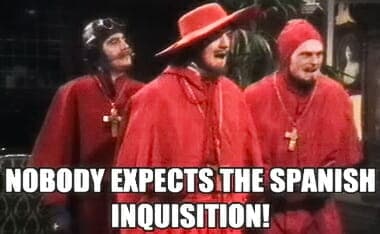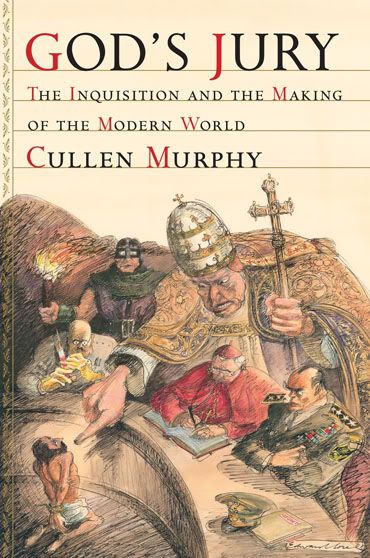This post is to just get on record some numbers about the Spanish Inquisition. A good summary is this one via Strange Notions, take note of the last bullet point:
• The Inquisition was originally welcomed to bring order to Europe because states saw an attack on the state’s faith as an attack on the state as well.
• The Inquisition technically had jurisdiction only over those professing to be Christians.
• The courts of the Inquisition were extremely fair compared to their secular counterparts at the time.
• The Inquisition was responsible for less than 100 witch-hunt deaths, and was the first judicial body to denounce the trials in Europe.
• Though torture was commonly used in all the courts of Europe at the time, the Inquisition used torture very infrequently.
• During the 350 years of the Spanish Inquisition, between 3,000-5,000* people were sentenced to death (about 1 per month).
• The Church executed no one.
[….]
In recent years, however, the Vatican opened up its secret archives for historical investigation. Inquisition records that were made by and for the Inquisition were allowed to be researched for the first time in history. Since then, the above facts have been generally discoverable in modern history books (whether Catholic or not). Corrected Inquisition history can be found in sources such as Inquisition by Edward Peters and The Spanish Inquisition: An Historical Revision by Henry Kamen. Comparative secular documentaries include The Myth of the Spanish Inquisition (BBC) and the more sensationalistic The Spanish Inquisition (History Channel).
(*See Kamen death totals below.)
Okay, the Catholic Church didn’t suppress science from Galileo, they didn’t kill him either, he died of old age. And in 350 years of the Spanish Inquisition, they killed about 3,000-to-5,000 people people due to it. here is this better understood history used in a debate between atheist
The above will play into another aspect of this story as well… that is, this was largely a secular movement. Continuing. The years in which the Inquisition was extremely active was between 1480 and 1530. Henry Kamen estimates about 2,000 executed, based on the documentation of the autos-da-fé, the great majority being conversos of Jewish origin. He offers striking statistics: 91.6% of those judged in Valencia between 1484 and 1530 and 99.3% of those judged in Barcelona between 1484 and 1505 were of Jewish origin. (WIKI, and Kamen’s book).
Here is Kamen’s commentary on the death toll:
In Castile the incidence of executions was probably higher. In the auto de fe at Ciudad Real on 23 February 1484, thirty people were burnt alive and forty in effigy; in the auto at Valladolid on 5 January 1492, thirty-two were burnt alive. The executions were, however, sporadic and concentrated only in the early years. In rounded terms, it is likely that over three-quarters of all those who perished under the Inquisition in the three centuries of its existence, did so in the first half-century. Lack of documentation, however, makes it impossible to arrive at totally reliable figures. One good estimate, based on documentation of the autos de fe, is that 250 people were burnt in person in the Toledo tribunal between 1485 and 1501 . Since this tribunal and that of Seville and Jaen were among the few in Castile to have had an intense level of activity, it would not be improbable to suggest a figure five times higher, around one thousand persons, as a rough total for those executed in the tribunals of Castile in the early period. Taking into account all the tribunals of Spain up to about 1530, it is unlikely that more than two thousand people were executed for heresy by the Inquisition.
Henry Kamen, The Spanish Inquisition: A Historical Revision (London, England: Yale University Press, 1997), 59-60.
Dennis Prager Comments on “Religious Violence” Via Prager’s “Masters Program.” (DAILY WIRE)
This is KEY!
Using Kamen’s numbers, about 6[-] people were killed a year by the Spanish Inquisition over its 350-year long stretch. If you use the high numbers, you get about 14[+] people killed a year. Below is Dinesh D’Souza referencing this information in a debate with an atheist
Secularism More Dangerous!
The Bible does not teach the horrible practices that some have committed in its name. It is true that it’s possible that religion can produce evil, and generally when we look closer at the details it produces evil because the individual people [Christians] are actually living in rejection of the tenets of Christianity and a rejection of the God that they are supposed to be following. So it [religion] can produce evil, but the historical fact is that outright rejection of God and institutionalizing of atheism (non-religious practices) actually does produce evil on incredible levels. We’re talking about tens of millions of people as a result of the rejection of God. For example: the Inquisitions, Crusades, Salem Witch Trials killed about anywhere from 40,000 to 80,000 persons combined (World Book Encyclopedia and Encyclopedia Americana), and the church is liable for the unjustified murder of about (taking the high number here) 300,000-women over about a 300 year period. A blight on Christianity? Certainly. Something wrong? Dismally wrong. A tragedy? Of course. Millions and millions of people killed? No. The numbers are tragic, but pale in comparison to the statistics of what non-religious criminals have committed); the Chinese regime of Mao Tse Tung, 60 million [+] dead (1945-1965), Stalin and Khrushchev, 66 million dead (USSR 1917-1959), Khmer Rouge (Cambodia 1975-1979) and Pol Pot, one-third of the populations dead, etc, etc. The difference here is that these non-God movements are merely living out their worldview, the struggle for power, survival of the fittest and all that, no evolutionary/naturalistic natural law is being violated in other words (as non-theists reduce everything to natural law — materialism). However, and this is key, when people have misused the Christian religion for personal gain, they are in direct violation to what Christ taught, as well as Natural Law.
A condensing of Gregory Koukl’s, “The Real Murderers: Atheism or Christianity?”
A recent comprehensive compilation of the history of human warfare, Encyclopedia of Wars by Charles Phillips and Alan Axelrod documents 1763 wars, of which 123 have been classified to involve a religious conflict. So, what atheists have considered to be ‘most’ really amounts to less than 7% of all wars. It is interesting to note that 66 of these wars (more than 50%) involved Islam, which did not even exist as a religion for the first 3,000 years of recorded human warfare. [That means that 2.6% of all wars fought are split up between Christianity, Buddhism, Hinduism, and the like.]
Even the Seven Years’ War, widely recognized to be “religious” in motivation, noting that the warring factions were not necessarily split along confessional lines as much as along secular interests. And the Thirty Years’ War cannot be viewed as “religious” either…read more
Dennis Prager makes a point that one of the common traits with the mass shooters is that they are never regular church goers. They are more likely to be secular… not taking into account the Judeo-Christian concept of God and the ethics that follow such a belief.
Not only that, the inquisition was largely secular. Ahhh, too bad history has a way of proving pop-theories of history and peoples use of misconception to tarnish the church when it was mainly secular authorities that did these horrible acts.wrong:
“The Inquisition had a secular character, although the crime was heresy. Inquisitors did not have to be clerics, but they did have to be lawyers. The investigation was rule-based and carefully kept in check. And most significantly, historians have declared fraudulent a supposed Inquisition document claiming the genocide of millions of heretics…. But the grand myth of thought control by sinister fiends has been debunked by the archival evidence….. he approach is purely historical, and therefore does not delve into ecclesial issues surrounding religious freedom. But perhaps this is proper. Because the crime was heresy, the Church is implicated, but the facts show it was a secular event……
…Sixtus IV promulgated a new bull categorically prohibiting the Inquisition’s extension to Aragon, affirming that,
▼ many true and faithful Christians, because of the testimony of enemies, rivals, slaves and other low people—and still less appropriate—without tests of any kind, have been locked up in secular prisons, tortured and condemned like relapsed heretics, deprived of their goods and properties, and given over to the secular arm to be executed, at great danger to their souls, giving a pernicious example and causing scandal to many.
In 1482 the pope was still trying to maintain control over the Inquisition and to gain acceptance for his own attitude towards the New Christians, which was generally more moderate than that of the Inquisition and the local rulers….
(Two different sources: Catholic Education Resource Center, and, Wiki [which is well referenced for further review].)
All this is to note the idea that skeptics have a distorted view of history precisely BECAUSE this view fits their presupposition that the “Church” (Christianity) is bad. Keep in mind it was still bad, Kamen notes right after the toll numbers: “The final death toll may have been smaller than historians once believed, but the overall impact was certainly devastating for the cultural minorities most directly affected.” We must keep in mind many were displaced and peoples faith were shaken as well as honed in trial and tribulation.
This is merely a side note and has nothing to do with the Spanish Inquisition as much as merely pointing out another time in history that is often overblown. Sensationalized in the aspect that mob mentality will quickly spread rumors and innuendo and act on IT rather than truth (ahem, Furguson), as was the case for the beginning of the Frech Revolution… which was opportunism taken by radicals in that society.
Dennis Prager interviews Ann Coulter in regards to her new book, Demonic: How the Liberal Mob Is Endangering America. Ann points out a fact that I wasn’t aware of in regards to the mob mentality that set the standard for the French Revolution. Much like the misunderstanding in regards to the Crusades, the witch trials, and the like, numbers are not the forte of the left… nor is putting into context meaning behind them.
For more clear thinking like this from Dennis Prager… I invite you to join Pragertopia: http://www.dennisprager.com/





